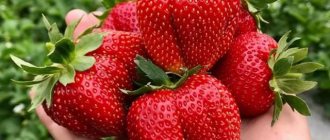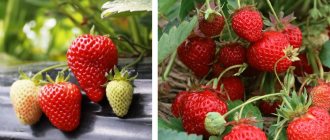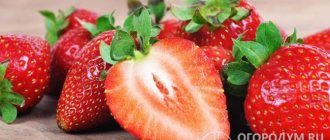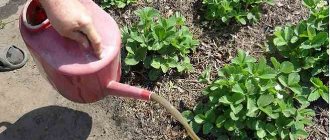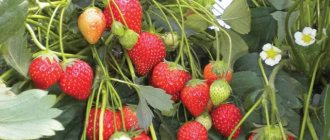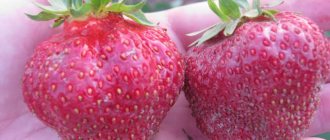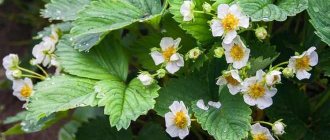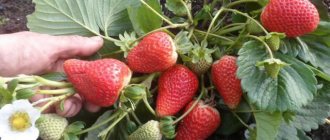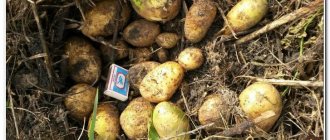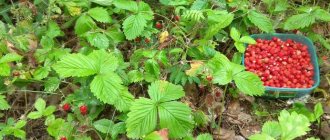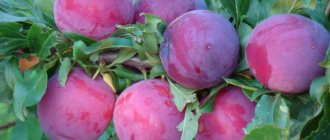Home / Garden / Berries
Back
Published: 02/19/2020
Reading time: 7 min
0
It’s rare to find garden strawberries, especially large-fruited ones, with diametrically opposed reviews about their taste. And Vikoda strawberries are just one of those varieties about which gardeners have never come to a consensus. Some talk about the sheer merits of the Dutch berry, while others, having harvested their first harvest, plan to uproot the bushes to replace them with others.
Why didn’t Vikoda strawberries please Russian summer residents? Maybe the reason is that the variety was not originally the goal of the breeders, but turned out by accident? But it’s not in vain that Vikoda’s strawberries were included in the Belarusian register, although according to experts, almost a point falls short of the highest rating of taste. Or is it that the characteristics of the berry crop did not live up to expectations due to weather and care? In search of answers, we study the description of the variety.
- 1 Varietal features 1.1 Plant
- 1.2 Berry
History of creation
This variety was obtained by scientists from the Netherlands randomly during breeding work in special areas of the Vissers company. Subsequently, this company copyrighted the Vikoda strawberry with the right to distribute it to other countries of the world.
This variety came to Russia at the beginning of this century, but was never included in the State Register of the country. But in Belarus, the Vikoda strawberry was officially included in the Register of Garden Plants in 2002.
According to reviews from summer residents, this Vikoda strawberry variety grows well and bears fruit in most regions, including the Urals and Siberia.
Varietal features
Sweet Victoria lovers try to plant bushes that can produce a harvest early: after a long winter, you want something sweet, aromatic, and juicy. But the zenith of summer has passed, and if there are no remontant strawberries on the plot, then wait for new berries until the next season. For those with a sweet tooth, the latest strawberry, the Vikoda variety, is an irreplaceable option.
It begins to bloom and bear fruit in the second half of summer, towards the end of July. Not for a week or two, but until the end of the season it pleases with fruits. But vicoda’s taste is really not for everyone – refined, slightly tart, with a delicate cherry tint. A rich bouquet at the end of summer.
Strawberry Vikoda: main characteristics and description of the variety
The Vikoda variety is late-ripening; the bushes are harvested in the second ten days of July. By this time, most other varieties of strawberries and garden strawberries have already finished bearing fruit. The Vikoda variety is not remontant.
INTERESTING to read!
• A selection of the 15 best strawberry varieties for Siberia
The bushes of this variety are quite tall, the flower stalks are powerful and strong, able to withstand a mass of ripe berries up to 70 g. The foliage is large, the upper leaf plates are slightly ribbed with fine teeth along the edges, their color is soft green. Petioles are less than medium in size, with light pubescence. Not too many whiskers are formed, so caring for this variety is simplified. The color of the mustache is pale red.
On the Vikoda strawberry, large female and male flowers appear simultaneously, not twisted, the color of the petals is boiling white.
The weight of the first ripe berries can reach 70 g (some can be 110-120 g); during the period of mass harvesting, the berries reach a weight of 30 g. The shape of ripe fruits can be irregularly conical, barrel-shaped, comb-shaped, ribbed, flattened. The color of the fruit is dark red, glossy. The pulp is quite dense, sweet, tender, and red in color. The appearance of a white spot at the tip of the berry indicates the onset of full ripeness of the fruit.
The taste of ripe berries is quite pleasant, including a slight tartness and a faint cherry aftertaste.
The amount of dry matter in Vikoda berries is about 11%, sugars - up to 9.1%, acids - no more than 1.15%, ascorbic acid - about 13 mg.
Interesting!
The tasting assessment of the ripe harvest of Vikoda strawberries on a 5-point scale is 4.1 points.
The collected fruits can be eaten fresh, made into jam, or frozen for the winter.
The variety's resistance to frost is relatively high - the bushes can winter without shelter at temperatures not lower than -20 degrees Celsius, but for the conditions of Siberia additional shelter for the strawberries will be required. This berry crop does not tolerate hot weather and periods of drought. Vikoda strawberries are highly resistant to a number of diseases that affect other varieties of this berry crop, including gray fruit rot, leaf spot, but have low resistance to powdery mildew and vertilosis.
Distinctive features of the variety
To get to know the Vikoda strawberry variety better, it’s worth considering the distinctive features:
- The first large fruits rarely grow straight into shape. Usually the berry is flattened. There are double fruits. By the time of ripening, many berries are able to restore the spherical shape characteristic of the variety.
- The readiness of strawberries for harvesting is indicated by the white color of the tip against the background of bright red pulp. The berry can be easily separated from the sepals and in this state can be stored or transported without losing its presentation.
- The aroma of ripe cherries is felt not only when eating the berry. A pleasant smell hangs over a clearing with ripe strawberries.
- The variety is not affected by putrefactive bacteria. Leaf spots rarely appear.
The advantages emphasize the superiority of Vikoda strawberries over other varieties:
- the bush produces about 1 kg of berries per season;
- strawberries do not freeze in winter even with weak shelter;
- The large fruits are not loose, which allows strawberries to be used in culinary dishes, for freezing, making juices, and preserving.
The disadvantage is the requirement of free space for growing Vikoda. To get a high yield of large berries, the bushes are planted far from each other, which is problematic in small areas. Another disadvantage is the loss of consistency of the berries when exposed to extreme heat.
This is interesting: Garden cranberries: learning the essence
The main pros and cons of the variety
Experts include the main positive qualities of Vigoda strawberry varieties:
- high productivity;
- large size of ripe berries;
- the harvested crop tolerates transportation well over long distances without losing its good taste and presentation;
- the Vikoda variety is frost-resistant;
- strawberries quickly adapt to different climatic conditions;
- this berry crop is resistant to most diseases characteristic of other strawberry varieties;
- ripe fruits are of universal use.
However, Vikoda strawberries also have disadvantages:
- the consistency of the berries may deteriorate due to heat;
- when planting bushes, the distance between them needs to be much greater than for other varieties of this berry crop.
Harvesting and storage
Ripe strawberries are a delicate product. Gardeners even argue that preserving them is sometimes more difficult than growing them. It is recommended to remove the berries of the variety under discussion for subsequent storage a few days before final ripening, when a greenish tint is observed on the white tip of the fruit. Then the berries are sorted. It should be borne in mind that large fruits are not suitable for storage - they are best eaten immediately. Smaller berries have better keeping quality. In addition, to prolong the shelf life of the fruits, they should not be removed from the stalks. Strawberries are harvested either in the morning, when the dew has already dried, or in the evening before sunset.
Important! Berries sent for storage should never be washed.
The berries are stored in one layer in wide and low wooden boxes lined with paper. The fruits collected and placed in boxes must be cooled to 0...+2°C. They can then be stored in the refrigerator for up to 4 days. The collected berries can also be frozen in the freezer, which will extend their shelf life to 1 year.
The Dutch strawberry variety Vikoda quickly gained popularity among gardeners in many countries around the world. This was facilitated by its high yield, the ability to quickly adapt to local climatic conditions, cold resistance and the original taste of the berries. Ripening the last strawberry among other varieties, Vikoda invariably puts a winning point in the completed strawberry season.
Planting Vikoda strawberries
The soil for planting this strawberry is prepared in advance - it is dug up, organic and mineral fertilizers are applied.
Photo of Vikoda strawberry on a bush
In the spring, bushes are planted at the end of April - beginning of May, when the soil warms up sufficiently.
In autumn, strawberries should be planted no later than September, so that the plants have time to adapt and take root well.
The planting area should be well illuminated by sunlight, and the soil should be loose and fairly fertile.
You can use nitrophoska or ammophoska or azofoska fertilizer for spring feeding of strawberry bushes, according to the information specified in the instructions for application to berry crops.
Important!
You should not get carried away with applying fertilizers containing large amounts of nitrogen, otherwise the plants will only increase the vegetative mass to the detriment of flowering and fruiting.
A set of care measures
In order for the strawberry harvest to please the gardener, it is necessary to carry out a regular set of measures to care for the plants. Vikoda needs timely watering and fertilizing, as well as preventive treatments against pest invasions.
Watering and fertilizing
Stagnation of moisture at the roots of berry plants is unacceptable; in case of waterlogging, fungal diseases quickly arise. Therefore, irrigation is carried out according to weather conditions.
Drip irrigation is the best way to irrigate strawberry beds. Humidification must be done in the morning or evening, it is important to use warm water.
Liquid mineral complexes are used as fertilizers. Once a season - before flowering, it is recommended to feed the strawberry bushes with infused chicken manure diluted with water in a ratio of 1:3. Drops of organic fertilizers are not allowed to get on the leaves of plants.
Weed control and soil mulching
After watering, Vikoda bushes are loosened and weeds are removed. Loosening is carried out superficially, with a depth of no more than 5 centimeters. Weeds must be removed regularly to avoid outbreaks of fungal diseases. Then the strawberries are mulched with a mixture of last year's humus and sand.
Fertilizing
Vikoda is characterized by weak bevel formation. On the one hand, this is convenient, the plantings are not thickened by children, but on the other hand, it is more difficult to propagate such strawberries. To stimulate the formation of whiskers, it is recommended to feed the bushes with nitrogenous fertilizers after fruiting.
On a note! Fertilizer is applied in liquid form directly under the root of the plant, without liquids getting on the leaves and stems.
Preventative treatments
To prevent fungal diseases, plants are sprayed with a solution of potassium permanganate or brilliant green twice a season: 10 drops of brilliant green are enough for 10 liters of water. Some gardeners use solutions with iodine.
Preparing for winter
Vikoda strawberries tolerate frost and frosty winters well. Does not need additional shelter for the winter. But some careful gardeners in the fall, after trimming the bushes, cover the beds with straw or special agrofibre.
Further care
Caring for Vikoda strawberries involves regular watering, fertilizing and (if necessary) covering the bushes before the onset of cold weather.
Strawberries need to be watered regularly to keep the top layer of soil constantly moist.
Fertilizers for Vikoda strawberries are applied several times per season:
- in the spring after the soil has warmed up well;
- at the beginning of flowering;
- during the period of active formation of ovaries;
- after harvest.
It is better to alternate the application of organic and mineral fertilizers.
Important!
You cannot apply fresh manure or chicken droppings under the bushes of this strawberry - you can burn the delicate root system of this berry plant. It is better to add humus or well-rotted compost.
Strawberry Vikoda - photo
Origin and zoning
“Vicoda” was obtained by Dutch specialists randomly in breeding plots (Vissers Aardbeiplanten BV), which issued a European patent for the variety and has the rights to distribute it. Domestic summer residents are well familiar with the results of this company’s many years of work from the “Vima” strawberry series, which also includes the popular late-ripening variety “Tarda,” which was bred as a result of crossing “Vikoda” with “Vima Zanta.” Unlike all “vim”, “Vikoda” is not officially registered in the State Register of the Russian Federation, but in 2002 it was included in the register of plants of Belarus as recommended for cultivation in open ground throughout the country. According to gardeners' reviews, Vikoda strawberries have also proven themselves well in central Russia, the Urals and Siberia, in the central and northwestern regions of Ukraine.
It is important to take into account that unlicensed distribution of planting material is prohibited and when purchasing seedlings of dubious origin, the risk of misgrading is very high. In addition, some unscrupulous sellers offer the variety under the guise of remontant, which it actually is not.
Diseases and pests
The Vigoda strawberry variety is resistant to most diseases and is almost not damaged by insect pests.
But preventive spraying of bushes should be carried out against powdery mildew and vertillosis, to which this plant has below average resistance.
To protect any variety of strawberry from vertillus, it is better to use a biological method, which consists in using antagonistic fungi, such as Talaromyces flavus, Trichoderma sp., Gliocladium roseum, Pseudomonas aureofaciens, to combat verticillium wilt. Based on them, such drugs as Trichocin, Glyokladin, Agat-25K were created.
How to properly care for strawberries
Proper care of any plant will ensure you a good harvest.
How to water strawberries
Vikoda strawberries love moisture, so watering should be regular. In spring, when there is no rain, water 1-2 times a week with warm water, in the morning or evening.
The use of drip irrigation will be useful.
The soil needs to be mulched to prevent moisture from evaporating. During heavy rains, it is advisable to stretch a film awning over the plantings to reduce flooding of the soil and erosion of the beds.
Mustache trimming
Pruning of plant tendrils is carried out for various reasons:
- plants require renewal every 4 years, this can be done with the help of mustaches;
- excess green mass takes nutrients and moisture from the bushes and thickens the plants;
- you need to prepare the strawberry bushes for winter.
It is important to do this in a timely and correct manner, taking into account the growing season of the plant:
- Trim the mustache for the first time in the spring, before the crop blooms. Nutrients should be directed to the growth and formation of berries.
- Repeat the procedure in the summer, after the strawberries bear fruit.
- Trim the mustache at a height of at least 10 cm from the ground using pruning shears.
- Treat the cut areas with a solution of potassium permanganate. To do this, water the plants with the preparation.
- At the same time as the mustache, remove the yellowed leaves and burn them. They may be infected with diseases.
- When pruning, do not damage the growing point of the bush.
Fertilizing Vikoda strawberries for a large harvest
The crop needs feeding all season long, like any plant. Feed the strawberries three times:
- in early spring,
- at the moment of budding
- and during the fruiting period.
For the first feeding, use 2 kg of rotted manure and 2 tablespoons of ammonium sulfate per bucket of water. Pour 0.5 liters of solution under each bush.
At the moment of budding of strawberries, apply 1 tablespoon of potassium salt and 2 tablespoons of nitrophoska to a bucket of water. Feed each bush with 0.5 liters of solution.
During the fruiting period, water the plants with 1 liter of bush food. Prepare a solution from spring mullein recipe with the addition of 1 tablespoon of complex fertilizer and 1 cup of wood ash.
Diseases and pests of Vikoda strawberries
Gardeners note the good resistance of Vikoda strawberries to bush diseases and fruit rot. But in any case, we recommend that you look at the article - Strawberry diseases and their treatment.
Despite its resistance to disease, the plant is susceptible to powdery mildew and verticillium.
Strawberry verticillium
It is better to prevent diseases:
- before planting, dip strawberry roots in a saturated solution of potassium permanganate;
- use copper-containing preparations in spring and autumn;
- try not to thicken the plantings and weed the plants in time.
The plant is attacked by crop pests
:
Strawberry mite.
A light beige microscopic insect invisible to the eye. Feeds on young shoots. The plant turns yellow, the leaves become wrinkled. In case of illness, you can use 5% Nero, 9 ml per hundred square meters.
Strawberry weevil.
This is a miniature insect 2-3 mm long. Eats plant buds. To fight, use the drug Karate according to the instructions.
Strawberry leaf beetle.
This is a bug measuring 3-4 mm. In spring it eats strawberry leaves on one side. Lays eggs before the crop blooms; larvae appear after 2 weeks. They skeletonize the leaves of the plant, and the strawberry may die. Apply Karate before flowering, 4-5 ml per hundred square meters.
Beetles - mowers
. A black or light brown insect 0.5-1 cm long. Its larvae are dangerous because they eat strawberry roots. To combat, use the drug Diazinon before planting, according to the instructions.
Root and strawberry nematodes.
A microscopic insect measuring 0.5 mm infects the roots of the plant and causes fungal infections. More often appears on tired soils. To destroy the pest, plant decorative marigolds nearby. Their roots secrete compounds that destroy the parasite. You can learn more about the benefits of marigolds here. It wouldn’t hurt to find out when to plant marigold seedlings.
Signs of a nematode on strawberry roots
The strawberry nematode sucks juice from the buds and leaves of the plant. Carries bacteria that cause June yellowing of strawberries and deformation of bushes. Timely weeding of plants and planting healthy bushes will help.
Preparing for winter
Experienced gardeners recommend pruning bushes before winter. The leaves may harbor infectious agents and pests. Pruning makes it easier to cover your strawberries. It is recommended to shed the bushes if there was no rain in September.
It is best to cover it with spruce branches; rodents will not grow under it. When using foliage, it must be dried. Place waterproof material over it. You can mulch the ground under the bushes with sawdust.
Types of reproduction
The main methods of propagation of the Vikoda strawberry variety are by mustaches and dividing the bushes.
How to propagate Vikoda strawberries with a mustache
This berry plant does not produce too many tendrils and this, on the one hand, is its advantage; on the other hand, it is not always possible to obtain a sufficient number of rosettes for subsequent propagation.
When propagating by mustache, you should remove everything except the first rosettes, which are dug in and watered regularly until young roots appear. The main sign of rooting is the appearance of several leaves on the rosette. In this case, you can separate the Vikoda strawberry seedling from the mother bush and replant it in a permanent place.
How to propagate strawberries with a mustache
Reproduction of the Vikoda variety by dividing the bush
These strawberries are propagated by dividing the bush, usually during mass transplantation of bushes to a new location (usually the transplantation procedure is carried out after 4-5 seasons). When replanting, carefully divide each bush into several divisions, each of which should have at least a pair of buds and several roots.
The cuttings are transplanted into pre-prepared beds and watered regularly. If the procedure is carried out correctly, the plants quickly adapt and grow.
Preparing soil and seedlings
According to gardeners, Vikoda strawberries love medium acidity soil. It is optimal to bring the pH to 5–6.5. The purchased seedlings are in no hurry to be sent to the garden. First, the plants are hardened off by taking them outside during the day. If seedlings are planted under film, it is enough to keep them in a cool place for at least two days. Hardening will help the Vikoda variety to quickly adapt to the external environment.
Important! To obtain good harvests, gardeners plant two seedlings in one hole. Joint growth promotes better growth of the root system.
When preparing new Vikoda seedlings, you should not rush to uproot all the old strawberries. Only part of the bushes are removed from the garden bed in a checkerboard pattern. You should end up with a pattern where young Vikoda is surrounded by old strawberries. Large bushes with broad foliage will protect new plantings from the wind.
Vikoda strawberries: reviews from those who planted them
Below are some of the reviews from summer residents who have been growing Vikoda strawberries for several seasons.
Natalia, 43 years old:
“I planted this variety of strawberries in my beds specifically so that I could harvest this berry crop in mid-July. Vikoda’s fruits are quite tasty and large, and I would also like to note the versatility of the harvest.”
STRAWBERRY!
• Zemklunika Kupchikha • variety Garland • Strawberry Darenka with a small number of mustaches
Elena, 37 years old:
“I have been growing the Vigoda strawberry variety in my garden for several seasons. I would like to note that this strawberry takes root well in a new place and is resistant to cold, but I still cover the bushes with spruce branches for the winter.”
Tatyana, 39 years old:
“The berries of this variety are very tasty and sweet and have a light fruity aftertaste. I prepare aromatic jam from ripe fruits and freeze them for the winter. The productivity is so high that the harvested crop is even enough for sale.”
Reviews
The grandchildren run to Vikoda first and call the berries mutants. The first fruits are really of any shape and size, 100 grams each. The bushes are large, I don’t get sick with anything, maybe because I don’t use mineral fertilizers. I compare it with my neighbor, she’s always either struggling with chlorosis or watching some Ganechkins. As a result, he just pours and sprinkles chemicals on the bushes, and the results are very modest. Manure and ash - this combination is quite enough for strawberry beds.
Vikoda gave me a number last year - it put on an incredible amount of mustache, I already thought it was a re-sort. This year I’m watching closely - everything has returned to normal, and I haven’t noticed a single antennae yet. Apparently it reacts to the weather this way; last season was rainy and cold, but this season the weather is warmer.
Vikoda strawberries are worthy of a place in any garden. From a small garden bed you can make compotes and jam for the whole family. After freezing, the berry reveals its potential even more and becomes more tasty. The bushes look gorgeous, the berries are huge, and the cherry aftertaste will not leave you indifferent.

